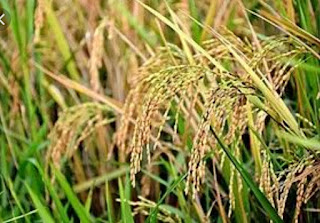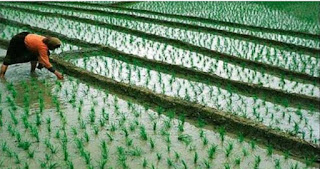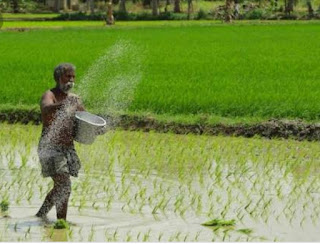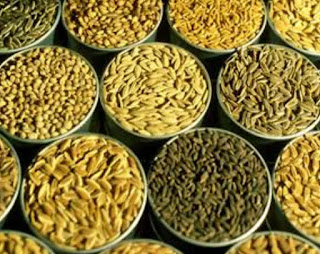Rice cultivation in india:
 |
| Rice cultivation in india |
Rice is the most important food crop of India. Which covers a quarter of the total cropped area. Rice is the food of about half of the Indian population. Rather it is widely eaten for a large part of the world's human population, especially in Asia.
After sugarcane and maize, it is the third largest agricultural commodity with worldwide production. Rice is one of the oldest known crops, it was grown in China about 5000 years ago.
3000 BC of rice in India Was discovered in This discovery was not made by any scientist but by farmers and native people. On the other hand, the export of rice from China was spreading to other countries of the world.
During the Harappan civilization in India, people lived around 2500 BC. Earlier people started developing rice. If we talk about Indian texts, then the mention of rice in the Yusurveda from 1500 to 1800 AD. The former has been done.
Rice farming is the main activity and source of income for millions of families across India. India receives foreign exchange and government revenue.
India is the second largest producer of rice. The government is also inventing new varieties to increase its yield. Which can increase the income of farmers, there is some suggestion for good yield of rice, by using which the farmer brothers can get good yield.
- Climate :
Rice is mainly a crop of warm and subtropical climate. Rice can be grown successfully in all areas where average temperature is 21 ° C or more for 4 to 6 months.
25 to 30 degree Celsius is suitable for good growth of the crop and 20 to 25 degree Celsius temperature for ripening. Lower the night temperature, the better for crop production. But should not fall below 15 ° C.
- Suitable land :
Soils with high water holding capacity, such as smooth, matiyar or matiyar-loam soils are often suitable for rice cultivation.
The pH value of the land is 5.5 to 6.5. Although rice can be cultivated in land with 4 to 8 or even more pH value, the most suitable soil is considered to be of pH 6.5. In alkaline and saline lands, rice can be successfully grown by using soil reformers properly.
- Crop rotation :
Potato, barseem, gram, lentils, mustard, sugarcane etc. are grown after cutting rice in the deep soil of northern India. One year crop cycle when irrigation, marketing etc. facilities are available in the plains of Northern India -
1. Rice-wheat-cowpea / moong (one year)
2. Rice-vegetable pea-maize (one year)
3. Rice-gram-maize + cowpea (one year)
4. Rice-Potato-Maize (one year)
1. Rice-wheat-cowpea / moong (one year)
2. Rice-vegetable pea-maize (one year)
3. Rice-gram-maize + cowpea (one year)
4. Rice-Potato-Maize (one year)
5. Rice-Lahi-Wheat (one year)
For rice cultivation, only the improved varieties should be used for their region, so that maximum yield can be obtained. Some of the major varieties for this are as follows,
Early varieties (110 to 115 days)
Early varieties (110 to 115 days)
They mainly include PNR- 381, PNR- 162, Narendra Dhan- 86, Govind, Saket- 4, Pusa- 2 & 21, Pusa- 33 & 834, and Narendra rice - 97 etc. varieties are prominent. Their nursery time is from 15 May to 15 June and their average yield is about 4.5 to 6.0 tonnes per hectare.
Medium duration varieties (120 to 125 days)
Medium duration varieties (120 to 125 days)
The main varieties are Pusa- 169, 205 and 44, Sarju- 52, Pant Dhan- 10, Pant Dhan- 12, IR- 64 etc. Their nursery time is from 15 May to 20 June and their average yield is around 5.5 to 6.5 tonnes per hectare.
Varieties of long duration (130 to 140 days) Pusa - 44, PR- 106, Malaviya- 36, Narendra- 359, Mahasuri etc. are the main varieties in this category. Their average yield is around 6.0 to 7.0 tonnes per hectare. Their nursery time is from 20 May to 20 June. Apart from these varieties, some of the major varieties planted in different parts of the country like IR-36, MTU-7029 (Swarna), MTU-1001 (Winner), MTU-1010 (Cotton Dora Sanhalu), There are BPT-5204 (Sambha Mahasuri), Advanced Sambha Mahasuri (Resistant to leaf scorching), Frontal, ADT-43 etc.
Hybrid Varieties (125 to 135 days)
These mainly include Pant hybrids Paddy-1, KRH-2, PSD-3, GK-5003, PA-6444, PA-6201, PA-6219 , DRRH-3, Indira Sona, Suruchi, Narendra Sankar Paddy-2, Pro Agro-6201, PHB-71, HRI-120, RH-204 and PRH-10 are hybrid varieties. Their average yield is around 6.5 to 8.0 tonnes per hectare.
Basmati varieties
Basmati varieties
Mainly Pusa Basmati - 1, Pusa Sugandha - 2, 3, 4 and 5, Kasturi - 385, Basmati - 370 and Basmati Taravadi etc. are prominent. Its nursery time is from 15 May to 15 June. Their average yield is around 5.5 to 7.0 tonnes per hectare.
Rice cultivation is mainly done in the lowlands. Also, rice is grown in high lands and deep water. Among the various methods of growing rice, rice density method, aerobic rice method and transplanting method are more important for Northern India. Hence, the above mentioned three methods are mentioned in detail as follows.
- Field preparation and sowing :
Rice cultivation is mainly done in the lowlands. Also, rice is grown in high lands and deep water. Among the various methods of growing rice, rice density method, aerobic rice method and transplanting method are more important for Northern India. Hence, the above mentioned three methods are mentioned in detail as follows.
 |
| Field preparation |
Rice Density Method (SRI method) :
1. This method is known as System of Rice Intensification or SRI or Intensification Method. With this method, the plantable age of the plant is 8 to 10 days or maximum 14 days for growing the rice. There should be minimum time between uprooting and planting in this field.
2. Field preparation is done in the traditional way. Pour water in the field and plow it 2 to 3 times with a plow or puddler that turns the soil.
2. Field preparation is done in the traditional way. Pour water in the field and plow it 2 to 3 times with a plow or puddler that turns the soil.
3. Planting of saplings is done at 25 x 25 cm transfer and only one plant is planted at one place. The main feature of this method is not to keep water standing in the field. It is necessary to keep the field always moist. Repeatedly irrigation is to be done at certain intervals and the field has to be water-free. So that there is enough air circulation in the soil.
4. Use of manual or rotating hoe is recommended to get rid of weed problem. This method increases weed control as well as air circulation in the soil. So that the growth of roots is good as well as weeds increase the amount of bio-matter in the soil after mixing it, which increases the number of beneficial organisms.
5. Nutrients in rice density system should be supplied from organic sources like compost, cow dung and green manure etc. If organic sources are not available in sufficient quantity, then essential nutrients can be supplied by integrated use of both fertilizers and organic sources.
6. Many benefits of growing rice with this method have come to the notice. For example, yields have been recorded at 1.5 to 3.0 times higher on rice density than traditional rice cultivation. Also, 30 to 40 percent less water is required in rice density than conventional rice system.
5. Nutrients in rice density system should be supplied from organic sources like compost, cow dung and green manure etc. If organic sources are not available in sufficient quantity, then essential nutrients can be supplied by integrated use of both fertilizers and organic sources.
6. Many benefits of growing rice with this method have come to the notice. For example, yields have been recorded at 1.5 to 3.0 times higher on rice density than traditional rice cultivation. Also, 30 to 40 percent less water is required in rice density than conventional rice system.
Aerobic rice
1. It is a modern method of growing rice in the event of less water available. Research tests have shown that the water productivity of aerobic rice is higher than that of rice growing method. In the unmanned condition of high yielding hybrid species for rice cultivation through aerobic (pneumatic) method, sowing directly in the field from seed drill or country plow and rice is grown like wheat. Along with this, they also irrigate the crop as per requirement.
2. Some hybrid varieties of rice like Anjali, Pro Agro 6111, PR-1160, PRH-10, Pusa 834, Sugandh-5 etc. can be grown successfully by aerobic method. 30 to 40 kg per hectare of seed is required for sowing in rows with native plow or seed drill.
3. The distance from row to row is found to be 25 centimeters more appropriate. If the moisture in the field is not sufficient, then the crop should be sown after pelvic or a light water should be applied immediately after sowing. The month of June is the suitable time for sowing in northern India.
2. Some hybrid varieties of rice like Anjali, Pro Agro 6111, PR-1160, PRH-10, Pusa 834, Sugandh-5 etc. can be grown successfully by aerobic method. 30 to 40 kg per hectare of seed is required for sowing in rows with native plow or seed drill.
3. The distance from row to row is found to be 25 centimeters more appropriate. If the moisture in the field is not sufficient, then the crop should be sown after pelvic or a light water should be applied immediately after sowing. The month of June is the suitable time for sowing in northern India.
4. 150 kg nitrogen, 60 kg phosphorus and 40 kg potash per hectare have been recommended for aerobic rice. Adding one-third of nitrogen and phosphorus and potash in garbage at the time of sowing is very beneficial. The remaining two-thirds of nitrogen should be divided into two equal parts and given at the time of formation and flowering.
5. The use capacity of nitrogen in rice can be increased by using neem-coated urea. It is necessary to have sufficient moisture in the field from the time the plant grows to the ripening stage. Research results have shown that 40 to 45 percent water is saved in aerobic rice compared to the popular rice growing method.
6. The problem of availability of iron element in aerobic rice can occur. Symptoms of deficiency of iron element on the plants are as follows - yellowing between the veins of leaves, gradually yellowing of entire leaves and finally yellowing of remaining parts of plants, etc. In the land where there is deficiency of iron element or if there is deficiency of iron element on the crop, then 0.5% ferrous sulphate or ferrous chilate solution should be sprayed 2-3 times at an interval of 15 days after bursting.
7. Growing of weeds is also a serious problem in aerobic rice. The problem of weeds can be reduced by spraying pendimethalin @ 1 kg per hectare within 2 to 3 days of sowing. 20, 20 days after sowing, 2, 4- D 0.5 kg of active ingredients per hectare can be sprayed to prevent wide leaf weeds.
8. There is also a strong possibility of loss by nematodes in aerobic rice. To control them, use 25 to 30 kg / ha of Carbofuron 3% g. Add carbofuron 20 to 30 days after germination, but at the time of planting make sure that there is enough moisture in the field.
6. The problem of availability of iron element in aerobic rice can occur. Symptoms of deficiency of iron element on the plants are as follows - yellowing between the veins of leaves, gradually yellowing of entire leaves and finally yellowing of remaining parts of plants, etc. In the land where there is deficiency of iron element or if there is deficiency of iron element on the crop, then 0.5% ferrous sulphate or ferrous chilate solution should be sprayed 2-3 times at an interval of 15 days after bursting.
7. Growing of weeds is also a serious problem in aerobic rice. The problem of weeds can be reduced by spraying pendimethalin @ 1 kg per hectare within 2 to 3 days of sowing. 20, 20 days after sowing, 2, 4- D 0.5 kg of active ingredients per hectare can be sprayed to prevent wide leaf weeds.
8. There is also a strong possibility of loss by nematodes in aerobic rice. To control them, use 25 to 30 kg / ha of Carbofuron 3% g. Add carbofuron 20 to 30 days after germination, but at the time of planting make sure that there is enough moisture in the field.
- Seed quantity and treatment for transplanting method :
Quantity of seed for transplanting method - healthy seeds should be trimmed before sowing. For this, 10% salt solution is used. To make a salt solution, dissolve 2.0 kg of normal salt in 20 liters of water and add 30 kg of seeds in this solution and shake it well, this will make healthy and heavy seeds sit down and little and light seeds will float up. In this way, clean and healthy pruned 20 kg seed in fine grain varieties and 25 kg seed in varieties of coarse grains is sufficient to prepare plants for transplanting one hectare.
- Treatment-
- Preparation of rice nursery
1. Nursery should be prepared in such land which is fertile, well drained and near water source. For planting rice in one hectare area, it is sufficient to prepare plants in 1/10 hectare (1000 sq m) area.
2. The exact time of sowing of rice nursery depends on different varieties. But the time from May 15 to June 20 has been found suitable for sowing.
3. The method of preparing seedlings of rice nursery is more prevalent in northern India. For this, plowing water in the field and plowing 2 to 3 times so that the soil becomes lush and weeds are destroyed. After the last plowing, plow the field by planting the field.
4. When there is no water on the soil surface, divide the field into 1.25 to 1.50 meters wide and convenient beds, so that the various cultivation operations of sowing, weeding and irrigation can be done easily.
5. After making the beds, fill water in the nursery to 5 cm height and spread the sprouted seeds evenly in the beds.
6. In an area of 1000 square meters of the nursery, about 700 to 800 kg of cow dung rotten manure, 8 to 12 kg of urea, 15 to 20 kg of single super phosphate, 5 to 6 kg of mites of potash and 2 to 2.5 kg of zinc sulphate is used in the field. It should be mixed well at the time of preparation.
2. The exact time of sowing of rice nursery depends on different varieties. But the time from May 15 to June 20 has been found suitable for sowing.
3. The method of preparing seedlings of rice nursery is more prevalent in northern India. For this, plowing water in the field and plowing 2 to 3 times so that the soil becomes lush and weeds are destroyed. After the last plowing, plow the field by planting the field.
4. When there is no water on the soil surface, divide the field into 1.25 to 1.50 meters wide and convenient beds, so that the various cultivation operations of sowing, weeding and irrigation can be done easily.
5. After making the beds, fill water in the nursery to 5 cm height and spread the sprouted seeds evenly in the beds.
6. In an area of 1000 square meters of the nursery, about 700 to 800 kg of cow dung rotten manure, 8 to 12 kg of urea, 15 to 20 kg of single super phosphate, 5 to 6 kg of mites of potash and 2 to 2.5 kg of zinc sulphate is used in the field. It should be mixed well at the time of preparation.
7. In areas where iron deficiency deficiency shows signs of dehumanization, spraying 0.5% ferrous sulfate solution at intervals of 2-3 times a week can be prevented in those areas.
8. Make sure weeding after 10 to 12 days in the nursery, if there is a possibility of more weeding in the nursery, then 120 to 120 ml of herbicide called Butachlor 50 EC or Banthiocarb in 60 liters of water, in the area of 1000 square meters, 4 to 5 Sprinkle before weeding the day after.
9. Thymethoate 30 EC, 2 ml drug per liter of water should be sprayed and sprayed as soon as the pests are out in the nursery.
10. Generally, when the plant is 21 to 25 days old and 5 to 6 leaves are left in it, then it is suitable for transplanting. The nursery should be watered well a day before planting, so that the seedlings can be uprooted easily and at the same time there is less damage to the roots of the plant.
planting :
9. Thymethoate 30 EC, 2 ml drug per liter of water should be sprayed and sprayed as soon as the pests are out in the nursery.
10. Generally, when the plant is 21 to 25 days old and 5 to 6 leaves are left in it, then it is suitable for transplanting. The nursery should be watered well a day before planting, so that the seedlings can be uprooted easily and at the same time there is less damage to the roots of the plant.
planting :
1. For transplanting, apply water in the nursery a day before uprooting and take care while uprooting the plants. While washing the roots of the plants, do not let them get damaged and hold the plants very low, plant the seedlings in rows.
2. The distance from row to row should be 20 cm and the distance from plant to plant should be 10 cm. Only plant 2 to 3 plants at one place, thus there should be about 50 plants in one square meter.
 |
| Rice transplanting |
- Nutrient management :
1. Green manure or cow dung or compost should be used to maintain high yield and fertility power of the land. The amount of nitrogen can be reduced if fenugreek or drench is used for green manure, because about 50 to 60 kg of nitrogen per hectare is obtained from the dill or drench.
2. Fertilizers should be used on land test basis, for dwarf varieties of rice 120 kg nitrogen, 60 kg phosphorus, 40 kg potash and 25 kg zinc sulfate per hectare.
3. For basmati varieties 100 to 120 kg of nitrogen, 50 to 60 kg of phosphorus, 40 to 50 kg of potash and 20 to 25 kg of zinc sulphate per hectare should be given.
2. Fertilizers should be used on land test basis, for dwarf varieties of rice 120 kg nitrogen, 60 kg phosphorus, 40 kg potash and 25 kg zinc sulfate per hectare.
3. For basmati varieties 100 to 120 kg of nitrogen, 50 to 60 kg of phosphorus, 40 to 50 kg of potash and 20 to 25 kg of zinc sulphate per hectare should be given.
 |
Fertilizer application
4. For hybrid rice, 130 to 140 kg of nitrogen, 60 to 70 kg of phosphorus, 50 to 60 kg of potash and 25 to 30 kg of zinc sulphate per hectare should be given.
5. Use the first third quantity of urea 5 to 8 days after transplanting when the plant is well taken root. The second one-third amount of urea should be sprayed at the standing crop (25 to 30 days after transplanting) and the remaining one-third before flowering (50 to 60 days after transplanting).
6. The entire amount of phosphorus should be mixed with single super phosphate or dye ammonium phosphate (DAP), also through the mute of potash and the entire amount of zinc sulphate in soil properly before transplanting the rice.
7. If for some reason zinc sulphate fertilizer is not applied at the time of planting, it can also be sprayed. For this, 3 sprays at intervals of 15 to 20 days should be done with 0.5% zinc sulfate + 0.25% quenched lime solution. Take the first spray a month after transplanting.
1. It is very important to have adequate irrigation facilities for the rice crop. Standing in the field about 5 to 6 centimeters of water is very beneficial if there is sufficient irrigation facility.
2. The field requires maximum water during the four stages of rice - transplanting, harvesting, earring, and filling the grain. At these stages, 5 to 6 centimeters of water must be filled in the field.
6. The entire amount of phosphorus should be mixed with single super phosphate or dye ammonium phosphate (DAP), also through the mute of potash and the entire amount of zinc sulphate in soil properly before transplanting the rice.
7. If for some reason zinc sulphate fertilizer is not applied at the time of planting, it can also be sprayed. For this, 3 sprays at intervals of 15 to 20 days should be done with 0.5% zinc sulfate + 0.25% quenched lime solution. Take the first spray a month after transplanting.
- water management
1. It is very important to have adequate irrigation facilities for the rice crop. Standing in the field about 5 to 6 centimeters of water is very beneficial if there is sufficient irrigation facility.
2. The field requires maximum water during the four stages of rice - transplanting, harvesting, earring, and filling the grain. At these stages, 5 to 6 centimeters of water must be filled in the field.
3. Irrigation should be stopped 15 days before harvesting by removing water from the field.
Hand weeding
1. Khurpi or pediweeder can be used to destroy weed in rice field.
2. Weedicides should be used for chemical weed control, some herbicides for weed control in rice fields are mentioned in the following array.
3. The required quantity of weedicide chemicals should be sprayed uniformly at the rate of per hectare by mixing in 500 to 600 liters of water.
Some of the main weedicides of rice are as follows-
2. Weedicides should be used for chemical weed control, some herbicides for weed control in rice fields are mentioned in the following array.
3. The required quantity of weedicide chemicals should be sprayed uniformly at the rate of per hectare by mixing in 500 to 600 liters of water.
Some of the main weedicides of rice are as follows-
 |
| Weedicides spray |
Anilophas
Benthiocarb
Pendimethalin
Aksadayjan
Oxiflofen
Pretilachlor
2, 4-D
Phenaczafrap
Bispyribac
Benthiocarb
Pendimethalin
Aksadayjan
Oxiflofen
Pretilachlor
2, 4-D
Phenaczafrap
Bispyribac
Also visit
https://agripoint8.blogspot.com/2020/06/how-to-manage-pest-on-paddy-field.html?m=1





0 Comments
Please do not enter any spam link on the comment box